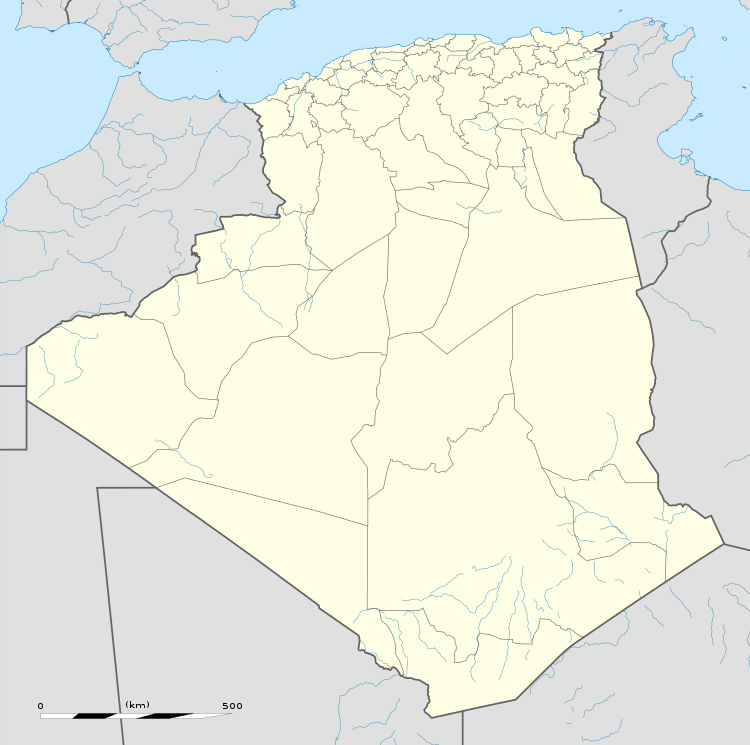Gerboise Blanche (nuclear test)
Gerboise Blanche (or Opération Gerboise Blanche) was the codename of the second French nuclear test. It was conducted by the Nuclear Experiments Operational Group (GOEN), a unit of the Joint Special Weapons Command[1] on 1 April 1960, at the Saharan Military Experiments Centre near Reggane, French Algeria in the Sahara desert region of Tanezrouft, during the Algerian War.[2][3]
| Gerboise Blanche | |
|---|---|
 Location of the test site | |
| Information | |
| Country | |
| Test series | Reggane series |
| Test site | Reggane, French Algeria |
| Coordinates | 26°09′58″N 00°06′09″W |
| Date | 1 April 1960 |
| Test type | Atmospheric |
| Test altitude | 0 m |
| Device type | A-bomb |
| Yield | 3 kt (12.5 TJ)[lower-alpha 1] |
| Test chronology | |
Name
Gerboise is the French word for jerboa, a desert rodent found in the Sahara. The color white (Blanche) adjuncted is said to come from the second colour of the French Flag.[4]
Test
Explosion
Gerboise Blanche operation was carried out 3 months after the success of the first test, Gerboise Bleue. Unlike the first attempt and the two others that were to come, this bomb was placed a few kilometres from ground zero, and detonated on a concrete pad.[5] This was a voluntary act of the authorities as they feared the usual test site would have been too contaminated for the next tests.[6]
On 1 April 1960 at 6:17:00 UTC,[7] the 1,250 kg plutonium filled fission bomb was detonated with a yield of 3 kt.[8] The explosion created a crater that was later filled in.[9] The Ministry of the Armed Forces subsequently asserted that the test paved the way for the miniaturization of this type of weapon, and that the lower yield was voluntary.[10] A 2001 document of the National Assembly confirmed this assertion while claiming that the bomb was an "emergency device" that would have been used had Gerboise Bleue failed.[6]
Fallouts
Initial monitoring reported a radiation dose of 100 rad/h at 3 km from ground zero one hour after the blast, and 0.3 rad/h at 45 km. Monitoring at Khartoum, around 3,400 km from Reggane, reported 10-10 Ci/m3.[8]
In 2005, the Algerian government asked for a study to assess the radioactivity of former nuclear testing sites. The International Atomic Energy Agency published the report suggesting that Gerboise Blanche explosion site had the highest Caesium-137 surface levels of the four tests, with a residual surface activity between 0.02 and 3.0 MBq/m² over a surface area of about 1 km².[11] The same report showed that while the fallouts of the 3 other tests of the Reggane series were contained in circular areas of less than 1 km in diametre, the fallouts of Gerboise blanche expanded south-west over a distance of more than 6 km.[12]
See also
- Agate (French first underground A-bomb)
- Canopus (French first atmospheric H-bomb)
- Force de Frappe
- List of states with nuclear weapons
- Nuclear weapons and France
- History of nuclear weapons
Notes
- Physician Pierre Billaud reported a yield of 4 kt (16.7 TJ). See External links.
References
- Sokolski, Henry D.; Tertrais, Bruno (2013). Nuclear Weapons Security Crises: What Does History Teach?. Strategic Studies Institute and U.S. Army War College Press. p. 31. ISBN 978-1-5848-7574-1.
- Senate of the French Republic (15 December 1997). "French Senate report #179: The first French tests in the Sahara". senat.fr (in French). Retrieved 9 August 2020.
- Garrett, Benjamin C. (2017). Historical Dictionary of Nuclear, Biological, and Chemical Warfare. Rowman & Littlefield. p. 124. ISBN 978-1-5381-0684-6.
- Kutchesfahani, Sara Z (2018). Global Nuclear Order. Routledge. ISBN 978-1-3519-9962-5.
- French Nuclear Tests Memorial. "Les essais aériens d'Hammoudia". moruroa.org (in French). Archived from the original on 3 November 2017.
- National Assembly of the French Republic (5 February 2001). "Rapport sur les incidences environnementales et sanitaires des essais nucleaires effectues par la France entre 1960 et 1996 et elements de comparaison avec les essais des autres puissances nucleaires" (PDF). senat.fr (in French). p. 27. Retrieved 10 August 2020.
- French Nuclear Testing, 1960-1988 (Technical report). Natural Defense Resources Council. 1989. p. 25. Retrieved 10 August 2020.
- Rapport sur les essais nucléaires français (1960-1996) (PDF) (Technical report). Government of the French Republic. p. 118. Retrieved 10 August 2020.
- Radiological Conditions at the Former French Nuclear Test Sites in Algeria: Preliminary Assessment and Recommendations (PDF) (Technical report). Vienna, Austria: International Atomic Energy Agency. 1 March 2005. p. 7; 10. Retrieved 10 August 2020.
- Pô, Jean-Damien (2001). Les moyens de la puissance: les activités militaires du CEA, 1945-2000 (in French). Ellipses. p. 138. ISBN 978-2-7298-0554-8.
- Radiological Conditions at the Former French Nuclear Test Sites in Algeria: Preliminary Assessment and Recommendations (PDF) (Technical report). Vienna, Austria: International Atomic Energy Agency. 1 March 2005. p. 9. Retrieved 10 August 2020.
- Radiological Conditions at the Former French Nuclear Test Sites in Algeria: Preliminary Assessment and Recommendations (PDF) (Technical report). Vienna, Austria: International Atomic Energy Agency. 1 March 2005. p. 10. Retrieved 10 August 2020.